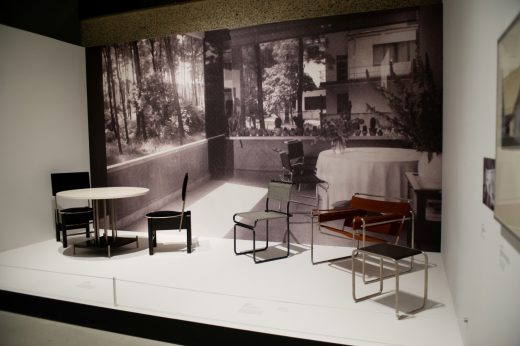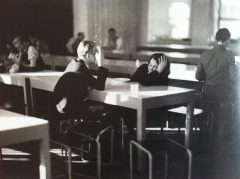
Exhibition:
Bauhaus: Art as Life
Barbican Art Gallery, London
May 3–August 12, 2012
Catalogue:
Bauhaus: Art as Life
London: Koenig Books, 2012.
288 pp.; 250 ills.
Cloth EUR 39,80
ISBN: 9783863351632
Bauhaus Travel Book
Edited by Bauhaus-Archiv Berlin, Stiftung Bauhaus Dessau, Klassik Stiftung Weimar.
Cologne: DuMont Buchverlag, 2012.
304 pp.; 232 ills.
Cloth EUR 19,95
ISBN: 9783832194123
In 1976 the German Democratic Republic repaired the Bauhaus building at Dessau. For those that visited in the years immediately after, the experience of an empty frame holds strong. The modest postcard packs produced for visitors comprised black and white photographs of the interior and exterior devoid of any human presence. Significant in formal and associative ways, the building stood emblematic of the School’s legacy and was defined in no small part by absences provoked and sustained by political forces. In the post-unification years the Dessau complex was restored fully and designated a UNESCO World Heritage site in 1996. The Barbican Art Gallery exhibition Bauhaus: Art as Life makes a bold attempt to reassemble the contents and experience of this building, and to some extent its forerunner in Weimar and subsequent iteration in Berlin, not by focusing solely on the best-known designers and the instantly recognizable objects that were created there but by attempting to convey ideas of community and communal life, educational and workshop experiences, the calendar of performances and parties, and the daily routines of living and working in this extraordinary environment.
The opening displays on the upper floor focus on the experiential themes and the educational principles developed at Weimar in an expressive, craft-orientated environment. These are then picked up again in the subsequent sections of the exhibition but shaped differently as a consequence of the turn toward rationality—the “purifying agency,” as Walter Gropius described it, rather than a “cardinal principle”—and the move to engage with technology and serial production that gained sway by the mid-1920s.1 The Dessau heydays are followed by a concluding section that explores the School’s move to Berlin and the impact of new staff—with photography and public architectural schemes coming to the fore—as the old guard departed and as political pressures encroached, and accelerated, to eventual closure in 1933.

The pursuit of the idea of “art as life,” from Weimar to Berlin via Dessau, creates a cohesive chronology that emphasizes continuity founded on principles and identity, which though molded by changing circumstance, managed on the whole to sustain staff transitions and remained independent of location. The energy of the Dessau years is rightly given center stage, with photographs, objects, and archive material employed to portray the exhilarating consolidation of ideas, effort, and identity that took place there. Although the famous orientation plan designed by Hinnerk Scheper describes by a series of arrows moving between floors—like choreographic notation—how people would circulate through the building, it is the photography, particularly of Lux Feininger and Lucia Moholy, that best conveys the texture of the experience within and around the building. An evocative small photographic print by Iwao Yamawaki, now at Tate, records two students in the canteen lingering after lunch, prolonging a conversation over the long table amid vacated Breuer B9 stools (Fig. 1). Turning round, one sees one of these stools in a sequence of furniture that includes items for the masters’ houses, and behind these, an enlarged view from Gropius’s own veranda (Fig. 2). This display approach serves to blend the relationships among students, teachers, and their families and focuses on the spaces they occupied together, rather than on individual careers or artifacts. Nonetheless, the developmental experiences of Bauhäuslers are interwoven: as we observe these chairs of Marcel Breuer’s, we might recall his expressionist woodcut Head, from 1923, in the upper galleries, that speaks of his student immersion in the fervent atmosphere of Johannes Itten’s preliminary course. Similarly, Marianne Brandt’s work is interspersed in different parts of the exhibition: her tea infusers feature in the early sections, her serially produced lighting and the accompanying catalogues are further on, and her remarkable photomontage of 1926 It’s a Matter of Taste is in one of the final displays on photography. In addition, the displays relating to the Dessau building include a photograph of Brandt relaxing on the balcony of the Prellerhaus, and a self-portrait in which she poses adorned in shining headband and collar for the legendary Metal Party of 1929.
While, rightly, exploring the School’s peculiarities, the exhibition, perhaps inadvertently, encourages the visitor to frame things in a wider cultural and political context. The partying photographs call to mind Christopher Isherwood’s Goodbye to Berlin, in which he depicts through a series of vignettes the city during the early 1930s, with characters both poor and wealthy trying to adapt to the modern world by attempting to be other than themselves—dressing up, posing, testing boundaries—against a background of increasingly unpredictable and sinister forces. The Bauhaus performances and self-consciousness make sense in this context and, while stemming from a position of cultural privilege, were acted out in similar ways.
The role of communication design was, and remains, a powerful component of the Bauhaus experience, and the exhibition conveyed this to good effect. From 1919 onward, printed materials were produced for both internal and external consumption, be they promotional—prospectuses, books, journals, posters—or transactional—catalogues, invoices, and letterheads for correspondence. All speak of the recognition that selling the Bauhaus as a concept was as important as, and a precursor to, selling the things that it made, although as Anna Rowland has pointed out, the former—certainly in the Weimar days—tended to be pursued at the expense of the latter.2 Idiosyncratic it might have appeared, yet the School dealt in the real world, with government officials to mollify, orders to fulfill, and bills to pay. Arguably, its cohesive graphic systems, fostered by László Moholy-Nagy and Herbert Bayer, came to function as ideological glue as the Bauhaus vacated its various homes and as its community dispersed, becoming in itself a “great structure”—the unified work of art which Gropius envisaged as the “ultimate, if distant aim.” After all, Lyonel Feininger’s woodcut Cathedral—which appeared on the title page of the manifesto and program of the Staatliches Bauhaus Weimar and is displayed in the exhibition adjacent to its block—was intended to be read as symbolic of a shared vision of collaborative endeavor and the absence of hierarchy among makers, the arts and crafts, the handmade, and the machine-made, rather than as a building per se. Indeed, Gropius’s understanding of the role of communications as a binding agent of the Bauhaus project was, and remains, critical. Mark Wigley has pointed out that Gropius’s strength lay in his ability to communicate: “[B]efore he designed objects, he designed relationships.”3 This aptitude for the role of ambassador and advocate is represented in documentation that the curators have included throughout the exhibition, and while the administrative burden was significant and often too much to cope with, we should not forget that Gropius’s spirituality was fundamental to his project, and he continued to argue that the aesthetic and the material “both find their counterpart in that unity which is life itself.”4
In the years between the closure of the Bauhaus in 1933 and the building of its archive, the School’s identity and the proselytizing role of its alumni and former staff transcended physical dispersal and fragmentation. Indeed, the formation of the archive was in itself an accumulative process required to create a “great structure” anew, and one demanding collaboration yet again. Gropius led by example, working with Charles L. Kuhn of the Busch-Reisinger Museum at Harvard from 1947. After they contacted former staff and students, “Bauhaus items of every description flowed into the Museum.”5 Gropius also collaborated closely with Hans Maria Wingler, who founded the Bauhaus Archive in Darmstadt in 1960. As part of the 1968 Bauhaus exhibition held at London’s Royal Academy of Arts, which then travelled to other venues around the world, the organizers employed similar methods. They wrote to every former Bauhäusler for whom Wingler had established contact details, as a means of gathering information and exhibits. In 1979, the structure designed by Gropius in 1964 to accommodate the archive in Darmstadt was opened, in modified form, in Berlin.
The motif of homes occupied and then vacated runs as a sub-story to the Barbican exhibition, and serves to emphasize the curatorial role, indeed as all the major Bauhaus exhibitions have done, in amalgamating, selecting, and re-arranging from the archive that which remains. Be the exhibits artifacts or artworks, photographs of people and spaces, or associated documentation, they speak of the Bauhaus as a concept but also of its origins. Thus an interesting tension plays out between the surviving material, the distributed heritage of the Bauhaus, and the places and structures to which it relates. For just as the school was located at different sites, so is its legacy. This is the challenge with which the three major custodians of Bauhaus history in Germany are faced and which they are tackling head on. The Bauhaus-Archiv Berlin/Museum Für Gestaltung, the Stiftung Bauhaus Dessau, and the Klassik Stiftung Weimar are now presenting a united front as the Bauhaus Kooperation Berlin Dessau Weimar, to deliver publications, web pages, and exhibitions (Bauhaus: A Conceptual Model with MoMA in 2009 and, in 2012, with the Barbican). Recently, they have produced the excellent Bauhaus Reisebuch and an accompanying app that, with texts by German authors, positively encourages an appreciation of the Bauhaus as an expanded map and one with Germany very much at its center. Bauhaus-relevant locations throughout the country are given center stage, and while the final brief section lists resources in France, Switzerland, Israel, the United States, and elsewhere, there is no doubt that promoting the Bauhaus as a national treasure is driving the Kooperation.
Ludwig Grote, one of the organizers of the 1968 exhibition, observed of the Bauhaus in his opening catalogue remarks that, “it has become an international concept, its name is no longer translated.”6 While the strength of Bauhaus as a concept endures, it is clear that its legacy is cohering both in actual and virtual space, and there is certainly renewed interest in its geographic footprint and in the “.de” of its top-level domain name. The Barbican exhibition served to evoke these fascinating tensions in ways more subtle than the subtitle “Art as Life” might suggest.
Catherine Moriarty is Curatorial Director of the University of Brighton Design Archives and Principal Research Fellow in the Faculty of Arts.
- 1. Walter Gropius, The New Architecture and the Bauhaus (London: Faber and Faber, 1935), 19.
- 2. Anna Rowland, “Business Management at the Weimar Bauhaus,” Journal of Design History 1, no. 3/4, (1988): 165.
- 3. Mark Wigley, “Whatever Happened to Total Design?” Harvard Design Magazine, no. 5 (Summer 1998), reprinted in Alex Coles, ed., Design and Art (London: Whitechapel Gallery/Cambridge, M.A.: MIT Press, 2007), 163.
- 4. Gropius, The New Architecture, 20.
- 5. Charles L. Kuhn, preface to Concepts of the Bauhaus: The Busch-Reisinger Museum Collection (Cambridge, M.A.: Harvard University Press, 1971), 8.
- 6. Ludwig Grote, “Walter Gropius and the Bauhaus,” Bauhaus: 50 Years (London: Royal Academy of Arts, 1968), 9.

Figure 1. Iwao Yamawaki, Canteen after lunch, Bauhaus Dessau, 1930–32 (printed 2010). Gelatin silver print, 8 x 11.1 cm. Tate. Purchased 1996 with funds provided by the Asia Pacific Acquisitions Committee.
